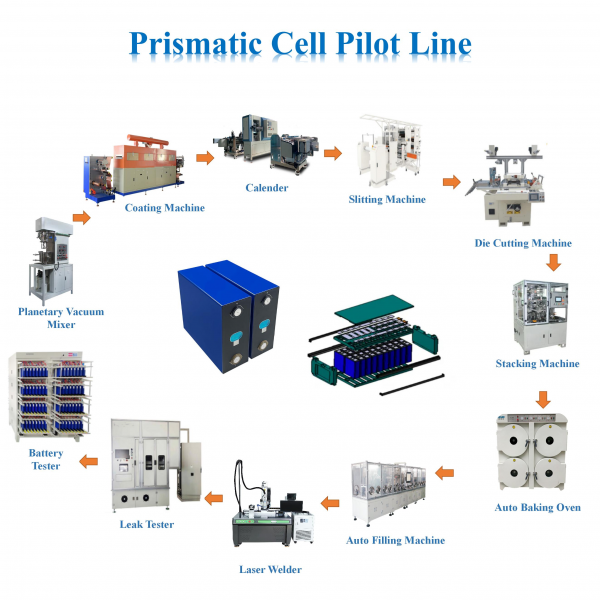- 電子メール : David@tmaxcn.com
- 電子メール : Davidtmaxcn@gmail.com
- : No. 39, Xinchang Road, Xinyang, Haicang Dist., Xiamen, Fujian, China (Mainland)
Introduction:
Our comprehensive solution for establishing a state-of-the-art prismatic cell fabrication line. This proposal outlines the detailed equipment, processes, and advantages of our solution, which aims to enable efficient and high-quality production of prismatic-shaped lithium-ion batteries.
1.Equipment:
a. Electrode Preparation:
Electrode Slitting Machine: This automated machine precisely cuts electrode materials into the desired dimensions required for cell assembly.
Electrode Coating Machine: The coating machine applies active materials onto the electrode sheets, ensuring uniform coverage and precise control of coating thickness.
Electrode Drying Oven: After the coating process, the electrode sheets are dried in this specialized oven to remove any residual solvents and ensure optimal adhesion of active materials.
b. Cell Assembly:
Electrode stacking machine: This automated equipment precisely stacks the positive and negative electrodes along with the separators. It ensures accurate alignment and uniform electrode spacing.
Winding Machine: The winding machine carefully rolls the stacked electrode assembly into a tightly wound cylindrical shape, ensuring consistent electrode contact and structural integrity.
Compression Machine: This machine applies controlled pressure to the wound electrode assembly, ensuring proper compaction and eliminating any air gaps between the layers.
c. Formation and Testing:
Formation Chamber: The formation chamber provides controlled environmental conditions for the initial charge and discharge cycles required to activate the electrode materials and stabilize their performance.
Testing and Sorting Machine: This machine conducts comprehensive electrical performance testing, capacity testing, and safety testing to ensure the quality and reliability of the prismatic cells.
d. Finishing and Packaging:
Tab Welding Machine: Tabs, which provide electrical connections to the prismatic cells, are welded onto the cells using this specialized equipment.
Insulation and Labeling Equipment: Insulation materials are applied to the cells to ensure electrical insulation and protection. Labels with important cell information, such as batch number and specifications, are also applied.
Packaging Machinery: Finished prismatic cells are carefully packaged into suitable containers or modules to protect them during transportation and storage.
2.Processes:
Our proposed prismatic cell fabrication line follows a detailed and systematic approach:
a. Electrode Preparation:
Slitting: The electrode sheets are precisely slit into the required dimensions using the electrode slitting machine.
Coating: The electrode coating machine applies active materials onto the electrode sheets, ensuring uniform coverage and precise control of coating thickness.
Drying: The coated electrodes are then dried in the electrode drying oven to remove any residual solvents and ensure optimal adhesion of the active materials.
b. Cell Assembly:
Stacking: The positive and negative electrodes, along with separators, are precisely stacked using the stacking machine, ensuring accurate alignment and uniform electrode spacing.
Winding: The stacked electrode assembly is carefully rolled into a tightly wound cylindrical shape using the winding machine, ensuring consistent electrode contact and structural integrity.
Compression: The wound electrode assembly undergoes compression using the compression machine, applying controlled pressure to eliminate any air gaps between the layers and ensuring proper compaction.
c. Formation and Testing:
Formation: The prismatic cells undergo an initial charge and discharge cycle in the formation chamber to activate the electrode materials and stabilize their performance.
Testing: The prismatic cells are subjected to comprehensive electrical performance testing, capacity testing, and safety testing using the testing and sorting machine to ensure their quality and reliability.
d. Finishing and Packaging:
Tab Welding: Tabs, providing electrical connections, are welded onto the prismatic cells using the tab welding machine.
Insulation and Labeling: Insulation materials are applied to the cells to ensure electrical insulation and protection. Labels containing essential cell information are applied for identification and traceability.
Packaging: The finished prismatic cells are carefully packaged into suitable containers or modules,ensuring their protection during transportation and storage. Packaging machinery is employed to facilitate efficient and secure packaging.
3.Advantages:
a. High Efficiency: Our prismatic cell fabrication line is designed for high-speed and automated production, ensuring efficient and consistent manufacturing processes. This results in increased productivity and reduced production time.
b. Precise Assembly: The advanced equipment in our fabrication line ensures precise electrode stacking, winding, and compression, leading to uniform cell structure and enhanced electrical performance.
c. Quality Control: The incorporation of comprehensive testing and sorting machines enables rigorous quality control measures, ensuring that only cells meeting strict performance and safety standards are released for use.
d. Flexibility and Scalability: Our prismatic cell fabrication line can be customized and scaled according to specific production requirements. It allows for easy adjustments in production capacity and the ability to accommodate future technological advancements.
e. Safety and Reliability: The adherence to strict quality control measures and the utilization of advanced testing equipment ensure the safety and reliability of the prismatic cells produced. This is crucial for applications that require stable and durable power sources.
4.Production Considerations:
a. Operator Training: Proper training and familiarization with the equipment and processes are essential for the efficient and safe operation of the prismatic cell fabrication line. Regular training sessions and ongoing support are recommended.
b. Maintenance and Calibration: Regular maintenance and calibration of the machinery are vital to sustain optimal performance and accuracy. Following manufacturer guidelines and scheduling preventive maintenance are recommended.
c. Safety Measures: The implementation of safety protocols, such as proper handling of hazardous materials, equipment safety features, and emergency response procedures, is crucial to ensure a safe working environment.
d. Compliance and Standards: It is important to adhere to relevant industry standards, regulations, and certifications during the prismatic cell fabrication process. Compliance with safety, environmental, and quality management systems is recommended.
In conclusion, our prismatic cell fabrication line offers a comprehensive solution for the efficient and reliable production of prismatic-shaped lithium-ion cells. With advanced equipment, precise assembly processes, rigorous quality control, and scalability, our solution ensures high-quality cells for various applications. By incorporating safety measures, operator training, and compliance with standards, we prioritize the well-being of our employees and the satisfaction of our customers.
 ru
ru English
English











 +86 13174506016
+86 13174506016 David@tmaxcn.com
David@tmaxcn.com

